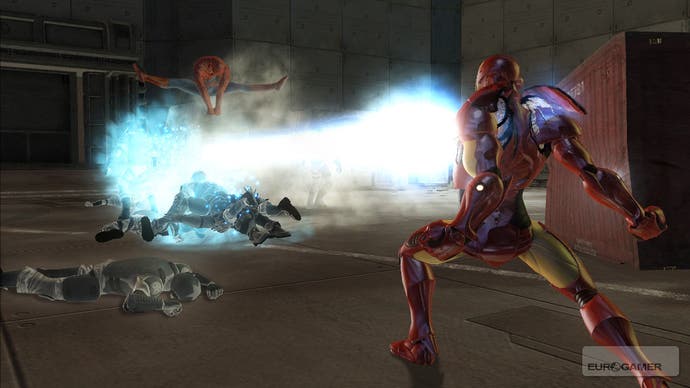Marvel Ultimate Alliance 2
Civil bore.
Marvel Ultimate Alliance 2 isn't vastly different to the first Marvel Ultimate Alliance, which was pretty similar to X-Men Legends 2, which owed more than a little to X-Men Legends. Trouble is, X-Men Legends came out in 2004, so the fact that the series has only shown incremental signs of evolution is cause for concern.
As before, a buffet of superheroes is spread out before you, all ready to mash their way through level after level of Diablo-style action-RPG gameplay at your command. You choose a squad of four - swapping them out on the fly, should you wish - and access their superpowers through the face buttons modified by the right trigger. Experience is earned for every enemy dispatched, and each level-up grants you the opportunity to enhance one or more of your abilities.
So far, so familiar, but this sequel does have a few new(ish) tricks up its sleeve. The biggest is the addition of Fusion attacks. These are earned by filling up a meter with normal melee and power attacks, and allow you to combine the talents of two of your heroes for one extra-powerful attack. There are three basic types, and which one you get depends on who you team up with. Targeted Fusions allow you to direct a strike at one specific enemy - ideal for bosses. Guided Fusions are ones you can steer around, great for mopping up scattered enemies. Clearing Fusions are wide-area attacks that come in handy should you get crowded. Each can be modified with a spot of button-bashing, to make them more effective.
It's a sound idea, if hardly original. The rather ropey game based on the last Fantastic Four movie did much the same thing, but at least here you've got 24 heroes to mix and match. Surely it must lead to a dazzling array of comic-book carnage, right? Well, sort of. It soon becomes clear that despite the large number of possible combinations, the Fusion attacks all fall into a handful of identical patterns. Once you've seen Hulk tear up a chunk of earth for Deadpool to pepper with bombs, before slamming it down on an enemy, there's limited enjoyment in seeing Thing and Human Torch do the exact same thing, only with fire. Or Luke Cage and Storm, with electricity. Or... well, suffice to say that the novelty soon wears off.

The other deviation from the norm is the two-pronged storyline, but again this proves to be less than inspiring in reality. Drawing on the Civil War storyline which splattered across Marvel's comic books in 2006 and 2007, a retaliatory attack from Latveria and an explosive showdown between superpowered foes in small-town USA cause the President to sign the Superhero Registration Act, requiring all heroes to register their identities and become officially sanctioned - and accountable - agents of the government.
The superhero community is soon split down the middle, with Iron Man leading the pro-registration faction, hunting down the rebel heroes who have gone underground led by Captain America. At the end of Act I of the game you get to choose whose side you'll take, but the impact this choice has on the game is disappointingly minor.
You'll still play the same levels in Act II, regardless of what you decide, and they still play out in much the same way. You'll encounter different sub-bosses, and have slightly different objectives, but it's hardly the sort of deviation that makes it worth playing through twice. It's even more pointless given that the game pulls everyone back together by Act III, and continues to play out in the exact same way until the end.


